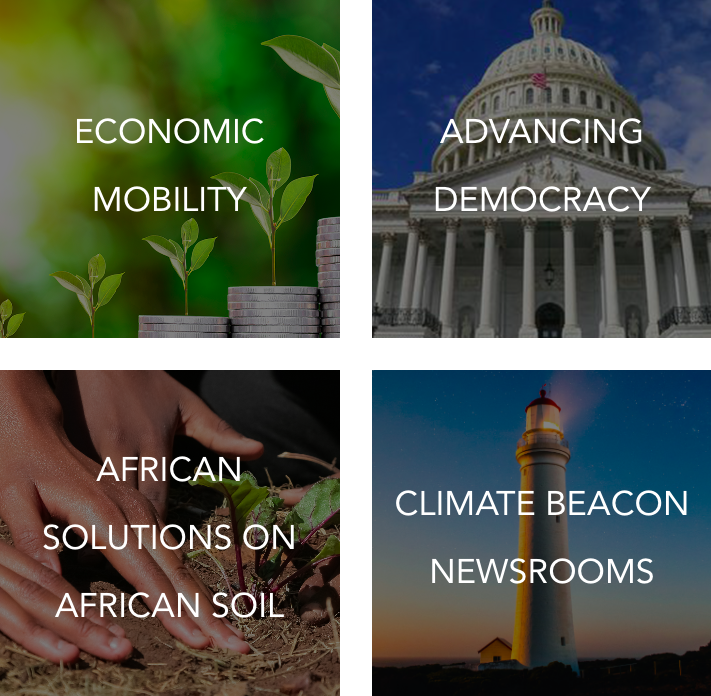As part of our winter membership drive, we are pulling back the curtain on what we do here at Reasons to be Cheerful. In this story, Contributing Editor Michaela Haas shares her perspective on solutions journalism. This is part one of a three-part series. Click here to read part two. Read part three here. Want to learn more about our membership program? Click here.
At the turn of this century, New York Times reporter Tina Rosenberg had uncovered a massive scandal but couldn’t convince her editor to publish her research: The price for HIV medication had soared. Thousands of patients in the Global South were dying because they could not afford the expensive treatment. “What people didn’t know was that the Clinton administration was colluding with the pharma industry to keep the prices artificially inflated,” the Pulitzer Prize-decorated Rosenberg says. Her editor at the New York Times Magazine agreed that the practice was scandalous but still, he was not willing to “print yet another depressing AIDS story!”
Rosenberg didn’t give up. Instead, she wrote a feature about a country that defied the pressure, produced the life-saving medication in its own labs and distributed it for free, effectively halving the death rate: Brazil.
The success of that New York Times cover story, “Look at Brazil,” was phenomenal: The US government changed its policy and the life-saving antiretrovirals became affordable in the global South. “This is exactly the principle,” Rosenberg said at a conference of the Solutions Journalism Network in Sundance, Utah, where I first met her: “Instead of just calling out a problem, we ask: Who does it better?”
Rosenberg suspected that the solutions principle would make sense for other topics, too. “The idea is too good to keep it to ourselves,” her colleague David Bornstein agreed, and in 2013, they co-founded the New York-based Solutions Journalism Network (SJN), which offers training and support for solutions journalism.
A little over five years ago, SJN retweeted a story of mine about finding post-traumatic growth. I had to look up what the network stood for. On its website, I read its definition of solutions journalism as “rigorous and compelling reporting about responses to social problems.” I was instantly hooked. It’s an evidence-driven approach that focuses on reproducible, effective solutions while not shying away from revealing limitations and shortcomings.

Shortly after, I began training in solutions journalism, started writing a solutions column for the German newspaper Süddeutsche Zeitung and coordinated a local solutions journalism community in Los Angeles before joining Reasons to be Cheerful as contributing editor in the spring of 2021.
Reasons to be Cheerful is one of only a handful of publications that exclusively publishes true solutions journalism. As a reader, you might have initially come here for the “cheer” in the name, and you might not necessarily have heard of solutions journalism. But if you read us, you know you won’t find cute kitten videos on our site to cheer you up (though there is nothing cuter than kittens).
Often, solutions journalism isn’t exactly “good” news. “Journalists are not interested in making people feel good,” Bornstein agrees. “In fact, when you look at a lot of solutions journalism, it’s not designed to make people feel better. It’s almost always stories about people who are performing poorly with problems compared to how they could be performing. It makes negligence egregious because there are other options. We think it is the most powerful way to shift journalism because accountability is our number-one job.”
The negativity bias has been well documented, including in one of my favorite books, the bestseller Factfulness by the late Hans Rosling: Readers believe the world is worse than it actually is. “When asked simple questions about global trends ― what percentage of the world’s population live in poverty; why the world’s population is increasing; how many girls finish school ― we systematically get the answers wrong,” Rosling and his co-authors find. “So wrong that a chimpanzee choosing answers at random will consistently outguess teachers, journalists, Nobel laureates, and investment bankers.”
No matter which pressing problems I think of, there are always people, communities or institutions who are working to solve them, and it is simply good journalism to research them. Solutions journalism fails when it is naïve and pollyanna-ish, but it does make me feel better to know that we live in a world where smart people who care are looking for solutions.
“If we only ever write about how people fail, it’s no surprise they don’t want to read us anymore,” Bornstein adds. “It makes you feel less helpless to live in a society where people are thinking about doing better.”
That’s why I’m convinced that solutions journalism is also a solution for the trust crisis in journalism. According to the latest comprehensive Digital News Report by the Reuters Institute, only four out of ten news consumers say they trust most news most of the time, and more than a third (36 percent) of news consumers say they avoid the news often or sometimes. News avoiders are more likely to say they are interested in solutions-based journalism.
“Journalism suffered an existential crisis along with its economic crisis, and solutions journalism is a way of responding to that, a way of increasing trust,” Rosenberg says. “People are assuming that trust is a function of accuracy, and we think it’s also a function of people feeling seen and respected by how the media portrays them.”
Studies show that solutions reporting rarely increases click rates but it increases the reading time by 10 to 20 percent, strengthens credibility and boosts reader engagement. Karen McIntyre, professor for multimedia journalism at the Virginia Commonwealth University, discovered that solutions journalism is also an antidote to feeling helpless and hopeless.
What began in Bornstein’s one-bedroom New York apartment a decade ago has now become an international network. SJN has trained more than 47,000 journalists in 160 countries, and curates a searchable database with solutions stories from 1,900 news organizations.
“People want more solutions journalism [with a focus on the climate crisis],” writes Mitali Mukherjee, who co-authored Reuters’ report on climate news use. “And essentially, that means that they’re looking for not just positive stories, but they’re looking for what’s working in a community and what might be replicated in another.”
What I personally appreciate most about this kind of solutions-focused journalism is its impact. I continue to be amazed how the stories change me and the readers.
After I wrote about the pesticide use and labor abuse in the flower industry, I stopped buying red roses for my spouse.
After I researched an in-depth feature on the climate diet (here’s a piece about the topic by my colleague Peter Yeung), I pivoted to plant-based meals.
Since I wrote about solutions for the increase in pedestrian deaths in the US, I approach crosswalks much more carefully.
I am a reporter, not an advocate. I won’t tell you what to make for dinner or who to vote for. But once we have all the facts clearly laid out with compelling evidence, it’s nearly impossible to ignore them.
I know this is the case for you, too, because you tell me so. Since focusing on solutions journalism, I’m getting significantly more mail from readers, and 99 percent of the people who write are genuinely engaged, interested, asking good questions or requesting more information so they can adopt an idea themselves. It’s fascinating and enriching! Very rarely do I get a letter that is insulting, and I believe this is also proof that we have earned your trust.
Weighed down by negative news?
Our smart, bright, weekly newsletter is the uplift you’ve been looking for.Also, it’s just simply more fun and more meaningful for me to interview people who actively tackle climate change/pollution/mental health/biodiversity or any number of issues I care about. “As a journalist who is often disturbed by the sad stories that make the news daily, it comes as a relief to do something different — tell stories of hope that illuminate a gloomy world,” freelance solutions reporter Olayide Oluwafunmilayo Soaga shared on Solutions Journalism Day.
I have been a reporter since I was 16 years old, writing stories about local politics and art reviews for my local paper after school. I honestly don’t think I would still be passionate about my job if I mainly wrote about what’s wrong with the world.
Also, in the last 20 years, I’ve lived in Europe, Asia and the US. I feel this is an advantage for solutions journalism because I have seen for myself how different countries grapple with problems that other countries have been able to solve. Switzerland has the lowest abortion rate in the world, Sweden recycles more glass (94 percent) than any other country, some countries have found solutions for rising gun deaths. Which means: Your country or community can solve the issue, too.
Bornstein sees solutions journalism as a way of shedding light on what’s possible, and maybe even changing what we see as possible. He quotes the saying that sunlight is the best disinfectant before adding, “Maybe it isn’t enough to shine a light on shortcomings, maybe journalism shouldn’t just play the role of disinfectant, but also photosynthesis.”
And that is a reason to be cheerful.












